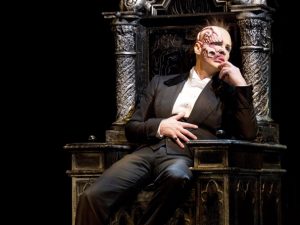I and the Phantom are back! Sorry for the two week delay; teaching picked up more quickly than anticipated.
So, as I was saying in my previous post, there is something rather appealing about the Phantom, despite the dark character traits he displays.
Years ago, I realized a strange, almost mirror-reflection for the Phantom – another outcast character whose primary reason for remaining hidden is physical deformity. Apart from that, the two are almost complete opposite – inside and out, pardon the pun.
In the Hunchback of Notre Dame, we observe Quasimodo, a kind soul trapped in a massively deformed body. He lives high above Paris in the belltower, where he lives with (and for) the music he makes with the bells. He is awestruck/lovestruck by Esmeralda, the girl who chooses another man (who doesn’t really care about her) and is heartbroken when she dies. A tragic hero, misjudged by society, one of the most enduring figures in Romantic literature.
In the Phantom of the Opera, we observe Erik, a brilliant man whose only physical deformity seems to reflect his vindictive, vicious nature. He lives in Paris, below the Opera House, and lives for the music that he composes. He too has a great love, and like Quasimodo, the girl rejects him for another man, but in this case the man actually cares for her in return. Erik gives her the choice of seeing her lover die or choosing life forever with her “angel of music.” In the end, he allows her to leave him to be with the man she loves while the Phantom disappears.
An interesting (and rather odd) contrast, wouldn’t you say?

